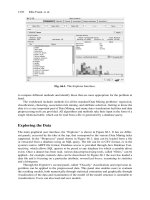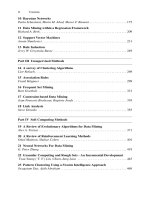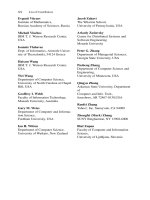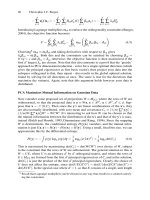Data Mining and Knowledge Discovery Handbook, 2 Edition part 30 ppsx
Bạn đang xem bản rút gọn của tài liệu. Xem và tải ngay bản đầy đủ của tài liệu tại đây (98.87 KB, 10 trang )
270 Lior Rokach
Clustering of objects is as ancient as the human need for describing the salient
characteristics of men and objects and identifying them with a type. Therefore, it
embraces various scientific disciplines: from mathematics and statistics to biology
and genetics, each of which uses different terms to describe the topologies formed
using this analysis. From biological “taxonomies”, to medical “syndromes” and ge-
netic “genotypes” to manufacturing ”group technology” — the problem is identical:
forming categories of entities and assigning individuals to the proper groups within
it.
14.2 Distance Measures
Since clustering is the grouping of similar instances/objects, some sort of measure
that can determine whether two objects are similar or dissimilar is required. There
are two main type of measures used to estimate this relation: distance measures and
similarity measures.
Many clustering methods use distance measures to determine the similarity or
dissimilarity between any pair of objects. It is useful to denote the distance between
two instances x
i
and x
j
as: d(x
i
,x
j
). A valid distance measure should be symmetric
and obtains its minimum value (usually zero) in case of identical vectors. The dis-
tance measure is called a metric distance measure if it also satisfies the following
properties:
1. Triangle inequality d(x
i
,x
k
) ≤ d(x
i
,x
j
) +d(x
j
,x
k
) ∀x
i
,x
j
,x
k
∈ S.
2. d(x
i
,x
j
)=0⇒ x
i
= x
j
∀x
i
,x
j
∈ S.
14.2.1 Minkowski: Distance Measures for Numeric Attributes
Given two p-dimensional instances, x
i
=(x
i1
,x
i2
, ,x
ip
) and x
j
=(x
j1
,x
j2
, ,x
jp
),
The distance between the two data instances can be calculated using the Minkowski
metric (Han and Kamber, 2001):
d(x
i
,x
j
)=(
x
i1
−x
j1
g
+
x
i2
−x
j2
g
+ +
x
ip
−x
jp
g
)
1/g
The commonly used Euclidean distance between two objects is achieved when
g = 2. Given g = 1, the sum of absolute paraxial distances (Manhattan metric) is
obtained, and with g=∞ one gets the greatest of the paraxial distances (Chebychev
metric).
The measurement unit used can affect the clustering analysis. To avoid the de-
pendence on the choice of measurement units, the data should be standardized. Stan-
dardizing measurements attempts to give all variables an equal weight. However, if
each variable is assigned with a weight according to its importance, then the weighted
distance can be computed as:
d(x
i
,x
j
)=(w
1
x
i1
−x
j1
g
+ w
2
x
i2
−x
j2
g
+ +w
p
x
ip
−x
jp
g
)
1/g
where w
i
∈ [0,∞)
14 A survey of Clustering Algorithms 271
14.2.2 Distance Measures for Binary Attributes
The distance measure described in the last section may be easily computed for
continuous-valued attributes. In the case of instances described by categorical, bi-
nary, ordinal or mixed type attributes, the distance measure should be revised.
In the case of binary attributes, the distance between objects may be calculated
based on a contingency table. A binary attribute is symmetric if both of its states
are equally valuable. In that case, using the simple matching coefficient can assess
dissimilarity between two objects:
d(x
i
,x
j
)=
r + s
q + r + s + t
where q is the number of attributes that equal 1 for both objects; t is the number of
attributes that equal 0 for both objects; and s and r are the number of attributes that
are unequal for both objects.
A binary attribute is asymmetric, if its states are not equally important (usually
the positive outcome is considered more important). In this case, the denominator
ignores the unimportant negative matches (t). This is called the Jaccard coefficient:
d(x
i
,x
j
)=
r + s
q + r + s
14.2.3 Distance Measures for Nominal Attributes
When the attributes are nominal, two main approaches may be used:
1. Simple matching:
d(x
i
,x
j
)=
p −m
p
where p is the total number of attributes and m is the number of matches.
2. Creating a binary attribute for each state of each nominal attribute and computing
their dissimilarity as described above.
14.2.4 Distance Metrics for Ordinal Attributes
When the attributes are ordinal, the sequence of the values is meaningful. In such
cases, the attributes can be treated as numeric ones after mapping their range onto
[0,1]. Such mapping may be carried out as follows:
z
i,n
=
r
i,n
−1
M
n
−1
where z
i,n
is the standardized value of attribute a
n
of object i. r
i,n
is that value before
standardization, and M
n
is the upper limit of the domain of attribute a
n
(assuming the
lower limit is 1).
272 Lior Rokach
14.2.5 Distance Metrics for Mixed-Type Attributes
In the cases where the instances are characterized by attributes of mixed-type, one
may calculate the distance by combining the methods mentioned above. For instance,
when calculating the distance between instances i and j using a metric such as the
Euclidean distance, one may calculate the difference between nominal and binary
attributes as 0 or 1 (“match” or “mismatch”, respectively), and the difference between
numeric attributes as the difference between their normalized values. The square of
each such difference will be added to the total distance. Such calculation is employed
in many clustering algorithms presented below.
The dissimilarity d(x
i
,x
j
) between two instances, containing p attributes of mixed
types, is defined as:
d(x
i
,x
j
)=
p
∑
n=1
δ
(n)
ij
d
(n)
ij
p
∑
n=1
δ
(n)
ij
where the indicator
δ
(n)
ij
=0 if one of the values is missing. The contribution of at-
tribute n to the distance between the two objects d
(n)
(x
i,
x
j
) is computed according to
its type:
• If the attribute is binary or categorical, d
(n)
(x
i
,x
j
) =0ifx
in
= x
jn
, otherwise
d
(n)
(x
i
,x
j
)=1.
• If the attribute is continuous-valued, d
(n)
ij
=
|
x
in
−x
jn
|
max
h
x
hn
−min
h
x
hn
, where h runs over all
non-missing objects for attribute n.
• If the attribute is ordinal, the standardized values of the attribute are computed
first and then, z
i,n
is treated as continuous-valued.
14.3 Similarity Functions
An alternative concept to that of the distance is the similarity function
s(x
i
,x
j
) that compares the two vectors x
i
and x
j
(Duda et al., 2001). This function
should be symmetrical (namely s(x
i
,x
j
)=s(x
j
,x
i
)) and have a large value when x
i
and x
j
are somehow “similar” and constitute the largest value for identical vectors.
A similarity function where the target range is [0,1] is called a dichotomous simi-
larity function. In fact, the methods described in the previous sections for calculating
the “distances” in the case of binary and nominal attributes may be considered as
similarity functions, rather than distances.
14.3.1 Cosine Measure
When the angle between the two vectors is a meaningful measure of their similarity,
the normalized inner product may be an appropriate similarity measure:
14 A survey of Clustering Algorithms 273
s(x
i
,x
j
)=
x
T
i
·x
j
x
i
·
x
j
14.3.2 Pearson Correlation Measure
The normalized Pearson correlation is defined as:
s(x
i
,x
j
)=
(x
i
− ¯x
i
)
T
·(x
j
− ¯x
j
)
x
i
− ¯x
i
·
x
j
− ¯x
j
where ¯x
i
denotes the average feature value of x over all dimensions.
14.3.3 Extended Jaccard Measure
The extended Jaccard measure was presented by (Strehl and Ghosh, 2000) and it is
defined as:
s(x
i
,x
j
)=
x
T
i
·x
j
x
i
2
+
x
j
2
−x
T
i
·x
j
14.3.4 Dice Coefficient Measure
The dice coefficient measure is similar to the extended Jaccard measure and it is
defined as:
s(x
i
,x
j
)=
2x
T
i
·x
j
x
i
2
+
x
j
2
14.4 Evaluation Criteria Measures
Evaluating if a certain clustering is good or not is a problematic and controversial
issue. In fact Bonner (1964) was the first to argue that there is no universal defini-
tion for what is a good clustering. The evaluation remains mostly in the eye of the
beholder. Nevertheless, several evaluation criteria have been developed in the litera-
ture. These criteria are usually divided into two categories: Internal and External.
14.4.1 Internal Quality Criteria
Internal quality metrics usually measure the compactness of the clusters using some
similarity measure. It usually measures the intra-cluster homogeneity, the inter-cluster
separability or a combination of these two. It does not use any external information
beside the data itself.
274 Lior Rokach
Sum of Squared Error (SSE)
SSE is the simplest and most widely used criterion measure for clustering. It is cal-
culated as:
SSE =
K
∑
k=1
∑
∀x
i
∈C
k
x
i
−
μ
k
2
where C
k
is the set of instances in cluster k;
μ
k
is the vector mean of cluster k. The
components of
μ
k
are calculated as:
μ
k, j
=
1
N
k
∑
∀x
i
∈C
k
x
i, j
where N
k
=
|
C
k
|
is the number of instances belonging to cluster k.
Clustering methods that minimize the SSE criterion are often called minimum
variance partitions, since by simple algebraic manipulation the SSE criterion may be
written as:
SSE =
1
2
K
∑
k=1
N
k
¯
S
k
where:
¯
S
k
=
1
N
2
k
∑
x
i
,x
j
∈C
k
x
i
−x
j
2
(C
k
=cluster k)
The SSE criterion function is suitable for cases in which the clusters form com-
pact clouds that are well separated from one another (Duda et al., 2001).
Other Minimum Variance Criteria
Additional minimum criteria to SSE may be produced by replacing the value of S
k
with expressions such as:
¯
S
k
=
1
N
2
k
∑
x
i
,x
j
∈C
k
s(x
i
,x
j
)
or:
¯
S
k
= min
x
i
,x
j
∈C
k
s(x
i
,x
j
)
14 A survey of Clustering Algorithms 275
Scatter Criteria
The scalar scatter criteria are derived from the scatter matrices, reflecting the within-
cluster scatter, the between-cluster scatter and their summation — the total scatter
matrix. For the k
th
cluster, the scatter matrix may be calculated as:
S
k
=
∑
x∈C
k
(x −
μ
k
)(x −
μ
k
)
T
The within-cluster scatter matrix is calculated as the summation of the last definition
over all clusters:
S
W
=
K
∑
k=1
S
k
The between-cluster scatter matrix may be calculated as:
S
B
=
K
∑
k=1
N
k
(
μ
k
−
μ
)(
μ
k
−
μ
)
T
where
μ
is the total mean vector and is defined as:
μ
=
1
m
K
∑
k=1
N
k
μ
k
The total scatter matrix should be calculated as:
S
T
=
∑
x∈C
1
,C
2
, ,C
K
(x −
μ
)(x −
μ
)
T
Three scalar criteria may be derived from S
W
, S
B
and S
T
:
• The trace criterion — the sum of the diagonal elements of a matrix. Minimizing
the trace of S
W
is similar to minimizing SSE and is therefore acceptable. This
criterion, representing the within-cluster scatter, is calculated as:
J
e
= tr[S
W
]=
K
∑
k=1
∑
x∈C
k
x −
μ
k
2
Another criterion, which may be maximized, is the between cluster criterion:
tr[S
B
]=
K
∑
k=1
N
k
μ
k
−
μ
2
• The determinant criterion — the determinant of a scatter matrix
roughly measures the square of the scattering volume. Since S
B
will be singu-
lar if the number of clusters is less than or equal to the dimensionality, or if m−c
is less than the dimensionality, its determinant is not an appropriate criterion. If
we assume that SW is nonsingular, the determinant criterion function using this
matrix may be employed:
276 Lior Rokach
J
d
=
|
S
W
|
=
K
∑
k=1
S
k
• The invariant criterion — the eigenvalues
λ
1
,
λ
2
, ,
λ
d
of
S
−1
W
S
B
are the basic linear invariants of the scatter matrices. Good partitions are ones
for which the nonzero eigenvalues are large. As a result, several criteria may be
derived including the eigenvalues. Three such criteria are:
1. tr[S
−1
W
S
B
]=
d
∑
i=1
λ
i
2. J
f
= tr[S
−1
T
S
W
]=
d
∑
i=1
1
1+
λ
i
3.
|
S
W
|
|
S
T
|
=
d
∏
i=1
1
1+
λ
i
Condorcet’s Criterion
Another appropriate approach is to apply the Condorcet’s solution (1785) to the rank-
ing problem (Marcotorchino and Michaud, 1979). In this case the criterion is calcu-
lated as following:
∑
C
i
∈C
∑
x
j
,x
k
∈C
i
x
j
= x
k
s(x
j
,x
k
)+
∑
C
i
∈C
∑
x
j
∈C
i
;x
k
/∈C
i
d(x
j
,x
k
)
where s(x
j
,x
k
) and d(x
j
,x
k
) measure the similarity and distance of the vectors x
j
and
x
k
.
The C-Criterion
The C-criterion (Fortier and Solomon, 1996) is an extension of Condorcet’s criterion
and is defined as:
∑
C
i
∈C
∑
x
j
,x
k
∈C
i
x
j
= x
k
(s(x
j
,x
k
) −
γ
)+
∑
C
i
∈C
∑
x
j
∈C
i
;x
k
/∈C
i
(
γ
−s(x
j
,x
k
))
where
γ
is a threshold value.
Category Utility Metric
The category utility (Gluck and Corter, 1985) is defined as the increase of the ex-
pected number of feature values that can be correctly predicted given a certain clus-
tering. This metric is useful for problems that contain a relatively small number of
nominal features each having small cardinality.
14 A survey of Clustering Algorithms 277
Edge Cut Metrics
In some cases it is useful to represent the clustering problem as an edge cut minimiza-
tion problem. In such instances the quality is measured as the ratio of the remaining
edge weights to the total precut edge weights. If there is no restriction on the size of
the clusters, finding the optimal value is easy. Thus the min-cut measure is revised to
penalize imbalanced structures.
14.4.2 External Quality Criteria
External measures can be useful for examining whether the structure of the clusters
match to some predefined classification of the instances.
Mutual Information Based Measure
The mutual information criterion can be used as an external measure for clustering
(Strehl et al., 2000). The measure for m instances clustered using C = {C
1
, ,C
g
}
and referring to the target attribute y whose domain is dom(y)={c
1
, ,c
k
} is de-
fined as follows:
C =
2
m
g
∑
l=1
k
∑
h=1
m
l,h
log
g·k
m
l,h
·m
m
.,l
·m
l,.
where m
l,h
indicate the number of instances that are in cluster C
l
and also in class c
h
.
m
.,h
denotes the total number of instances in the class c
h
. Similarly, m
l,.
indicates the
number of instances in cluster C
l
.
Precision-Recall Measure
The precision-recall measure from information retrieval can be used as an external
measure for evaluating clusters. The cluster is viewed as the results of a query for
a specific class. Precision is the fraction of correctly retrieved instances, while re-
call is the fraction of correctly retrieved instances out of all matching instances. A
combined F-measure can be useful for evaluating a clustering structure (Larsen and
Aone, 1999).
Rand Index
The Rand index (Rand, 1971) is a simple criterion used to compare an induced clus-
tering structure (C
1
) with a given clustering structure (C
2
). Let a be the number of
pairs of instances that are assigned to the same cluster in C
1
and in the same cluster
in C
2
; b be the number of pairs of instances that are in the same cluster in C
1
,but
not in the same cluster in C
2
; c be the number of pairs of instances that are in the
same cluster in C
2
, but not in the same cluster in C
1
; and d be the number of pairs of
instances that are assigned to different clusters in C
1
and C
2
. The quantities a and d
278 Lior Rokach
can be interpreted as agreements, and b and c as disagreements. The Rand index is
defined as:
RAND =
a + d
a + b + c + d
The Rand index lies between 0 and 1. When the two partitions agree perfectly, the
Rand index is 1.
A problem with the Rand index is that its expected value of two random cluster-
ing does not take a constant value (such as zero). Hubert and Arabie (1985) suggest
an adjusted Rand index that overcomes this disadvantage.
14.5 Clustering Methods
In this section we describe the most well-known clustering algorithms. The main
reason for having many clustering methods is the fact that the notion of “cluster” is
not precisely defined (Estivill-Castro, 2000). Consequently many clustering methods
have been developed, each of which uses a different induction principle. Farley and
Raftery (1998) suggest dividing the clustering methods into two main groups: hier-
archical and partitioning methods. Han and Kamber (2001) suggest categorizing the
methods into additional three main categories: density-based methods, model-based
clustering and grid-based methods. An alternative categorization based on the in-
duction principle of the various clustering methods is presented in (Estivill-Castro,
2000).
14.5.1 Hierarchical Methods
These methods construct the clusters by recursively partitioning the instances in ei-
ther a top-down or bottom-up fashion. These methods can be sub-divided as follow-
ing:
• Agglomerative hierarchical clustering — Each object initially represents a clus-
ter of its own. Then clusters are successively merged until the desired cluster
structure is obtained.
• Divisive hierarchical clustering — All objects initially belong to one cluster.
Then the cluster is divided into sub-clusters, which are successively divided into
their own sub-clusters. This process continues until the desired cluster structure
is obtained.
The result of the hierarchical methods is a dendrogram, representing the nested
grouping of objects and similarity levels at which groupings change. A clustering
of the data objects is obtained by cutting the dendrogram at the desired similarity
level.
The merging or division of clusters is performed according to some similarity
measure, chosen so as to optimize some criterion (such as a sum of squares). The
hierarchical clustering methods could be further divided according to the manner
that the similarity measure is calculated (Jain et al., 1999):
14 A survey of Clustering Algorithms 279
• Single-link clustering (also called the connectedness, the minimum
method or the nearest neighbor method) — methods that consider the distance
between two clusters to be equal to the shortest distance from any member of one
cluster to any member of the other cluster. If the data consist of similarities, the
similarity between a pair of clusters is considered to be equal to the greatest simi-
larity from any member of one cluster to any member of the other cluster (Sneath
and Sokal, 1973).
• Complete-link clustering (also called the diameter, the maximum
method or the furthest neighbor method) - methods that consider the distance
between two clusters to be equal to the longest distance from any member of one
cluster to any member of the other cluster (King, 1967).
• Average-link clustering (also called minimum variance method) - methods that
consider the distance between two clusters to be equal to the average distance
from any member of one cluster to any member of the other cluster. Such clus-
tering algorithms may be found in (Ward, 1963) and (Murtagh, 1984).
The disadvantages of the single-link clustering and the average-link clustering can
be summarized as follows (Guha et al., 1998):
• Single-link clustering has a drawback known as the “chaining effect“: A few
points that form a bridge between two clusters cause the single-link clustering to
unify these two clusters into one.
• Average-link clustering may cause elongated clusters to split and for portions of
neighboring elongated clusters to merge.
The complete-link clustering methods usually produce more compact clusters and
more useful hierarchies than the single-link clustering methods, yet the single-link
methods are more versatile. Generally, hierarchical methods are characterized with
the following strengths:
• Versatility — The single-link methods, for example, maintain good performance
on data sets containing non-isotropic clusters, including well-separated, chain-
like and concentric clusters.
• Multiple partitions — hierarchical methods produce not one partition, but mul-
tiple nested partitions, which allow different users to choose different partitions,
according to the desired similarity level. The hierarchical partition is presented
using the dendrogram.
The main disadvantages of the hierarchical methods are:
• Inability to scale well — The time complexity of hierarchical algorithms is at
least O(m
2
) (where m is the total number of instances), which is non-linear with
the number of objects. Clustering a large number of objects using a hierarchical
algorithm is also characterized by huge I/O costs.
• Hierarchical methods can never undo what was done previously. Namely there is
no back-tracking capability.









